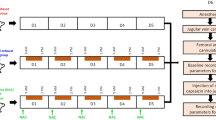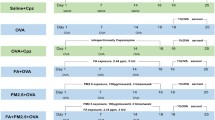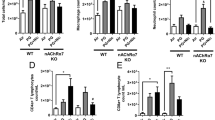Abstract
This study characterizes the molecular neurotoxicity of diesel exhaust (DE) on the tachykinin substance P (SP) signaling system in the lungs. A total of 96 female Fischer 344/NH rats (~175 g, ~4 weeks old) were randomly assigned to eight groups in a 2×4 factorial design: capsaicin versus non-capsaicin (vehicle) pretreatment, and filtered room air versus two exposure levels of DE with diesel engine room control. The rats were exposed nose-only to room air or low (35.3 µg/m3) and high concentrations (669.3 µg/m3) particulates directly from a Cummins N14 research engine at 75% throttle for 4 h/day, 5 days/week, for 3 weeks. The findings showed that exposure to DE dose-dependently induced bronchopulmonary neurogenic inflammation, both in capsaicin- and vehicle-pretreated rats, as measured by plasma extravasation, edema, and inflammatory cells. DE inhalation affected the SP signaling processes, including stored SP depletion and the gene/protein overexpression for neurokinin-1 receptor. DE also significantly reduced the activity of neutral endopeptidase, a main degradation enzyme for SP. Consequently, these changes may be regarded as critical factors that switched neurogenic pulmonary responses from their protective functions to a detrimental role that perpetuates lung inflammation. These changes may possibly be associated with the mass concentration of DE particles due to their physico-chemical characteristics. Moreover, capsaicin-pretreated rats had more sensitivity to these levels of DE exposure due to stimulation of bronchopulmonary C-fibers. However, the effects of capsaicin treatment were not consistent and apparent in this study. Taken together, our findings suggest that neurokininergic mechanisms may possibly be involved in DE-induced lung inflammation, but that bronchopulmonary C-fibers did not dominate DE-induced inflammatory abnormalities.









Similar content being viewed by others
References
American Thoracic Society, Committee of the Environmental and Occupational Health Assembly (1996) Health effects of outdoor air pollution. Am J Respir Crit Care Med 153:3–50
Bonham AC, Kott KS, Joad JP (1996) Sidestream smoke exposure enhances rapidly adapting receptor responses to substance P in young guinea pigs. J Appl Physiol 81:1715–1722
Bozic CR, Lu B, Hopken UE, Gerard C, Gerard NP (1996) Neurogenic amplification of immune complex inflammation. Science 273:1722–1725
California EPA (Environmental Protection Agency) (1998) Part B: health risk assessment for diesel exhaust, proposed identification of diesel exhaust as a toxic air contaminant. Office of Environmental Health Hazard Assessment, Air Resources Board, Sacramento
Dawson SV, Alexeeff GV (2001) Multi-stage model estimates of lung cancer risk from exposure to diesel exhaust, based on a U.S. railroad worker cohort. Risk Anal 21:1–18
Delaunois A, Segura P, Dessy-Doize C, Ansay M, Montano LM, Vargas MH, Gustin P (1997) Ozone-induced stimulation of pulmonary sympathetic fibers: a protective mechanism against edema. Toxicol Appl Pharmacol 147:71–82
Delfino RJ (2002) Epidemiologic evidence for asthma and exposure to air toxics: linkages between occupational, indoor, and community air pollution research. Environ Health Perspect 110 [Suppl 4]:573–589
EPA (US Environmental Protection Agency) (2002) Health assessment document for diesel engine exhaust. Document EPA/600/8-90/057F. US EPA, Office of Research and Development, National Center for Environmental Assessment, Washington DC
Hashimoto K, Ishii Y, Uchida Y, Kimura T, Masuyama K, Morishima Y, Hirano K, Nomura A, Sakamoto T, Takano H, Sagai M, Sekizawa K (2001) Exposure to diesel exhaust exacerbates allergen-induced airway responses in guinea pigs. Am J Respir Crit Care Med 164:1957–1963
HEI (Health Effects Institute) (1995) Diesel exhaust: a critical analysis of emissions, exposure, and health effects. A special report of the Institute's Diesel Working Group. Health Effects Institute, Cambridge MA
HEI (Health Effects Institute) (1999) Diesel emissions and lung cancer: epidemiology and quantitative risk assessment. A special report of the Institute's Diesel Working Group. Health Effects Institute, Cambridge MA
Iwai K, Adachi S, Takahashi M, Moller L, Udagawa T, Mizuno S, Sugawara I (2000) Early oxidative DNA damages and late development of lung cancer in diesel exhaust-exposed rats. Environ Res 84:255–264
Jimba M, Skornik WA, Killingsworth CR, Long NC, Brain JD, Shore SA (1995) Role of C fibers in physiological responses to ozone in rats. J Appl Physiol 78:1757–1763
Joad JP, Kott KS, Bonham AC (1997) Nitric oxide contributes to substance P-induced increases in lung rapidly adapting receptor activity in guinea pigs. J Physiol (Lond) 503:635–643
Killingsworth CR, Paulauskis JD, Shore SA (1996) Substance P content and preprotachykinin gene-I mRNA expression in a rat model of chronic bronchitis. Am J Respir Cell Mol Biol 14:334–340
Killingsworth CR, Shore SA, Alessandrini F, Dey RD, Paulauskis JD (1997) Rat alveolar macrophages express preprotachykinin gene-I mRNA-encoding tachykinins. Am J Physiol 273:L1073–L1081
Krause JE, Bu JY, Takeda Y, Blount P, Raddatz R, Sachais BS, Chou KB, Takeda J, McCarson K, DiMaggio D (1993) Structure expression and second messenger-mediated regulation of the human and rat substance P receptors and their genes. Regul Pept 46:59–66
Kweon CB, Foster DE, Schauer JJ, Okada S (2002) Detailed chemical composition and particle size assessment of diesel engine exhaust. Society of Automotive Engineers (SAE) 2002 Powertrain and Fluid Systems Conference, 21–24 October 2002, San Diego. SAE Technical Papers, Document No. 2002-01-2670. Available via http://www.sae.org
Kweon C, Okada S, Bae M, Mieritz M, Schauer JJ, Foster DE (2003) Effect of engine operating conditions on organic compounds in engine exhaust of a heavy-duty (HD) direct-injection (DI) diesel engine. Society of Automotive Engineers (SAE) 2003 World Congress. MArch2003, Detroit. SAE Technical Papers, Document No. 2003-01-0342. Available via http://www.sae.org
Lambrecht BN (1987) Substance P receptor-dependent responses of leukocytes in pulmonary inflammation. Am Rev Respir Dis 136:S39–S43
Lambrecht BN (2001) Immunologists getting nervous: neuropeptides, dendritic cells and T cell activation. Respir Res 2:133–138
Lilly CM, Drazen JM, Shore SA (1993) Peptidase modulation of airway effects of neuropeptides. Proc Soc Exp Biol Med 203:388–404
Long NC, Abraham J, Kobzik L, Weller EA, Krishna Murthy GG, Shore SA (1999) Respiratory tract inflammation during the induction of chronic bronchitis in rats: role of C-fibres. Eur Respir J 14:46–56
Lough GC, Shafer MM, Schauer JJ (2000) ICP-MS analysis of ultra-trace metals present in fine particulate matter. In: Proceedings of 93rd A&WMA (Air and Waste Management Association) National Meeting, Salt Lake City. Available via http://www.awma.org
Lucchini RE, Springall DR, Chitano P, Fabbri LM, Polak JM, Mapp CE (1996) In vivo exposure to nitrogen dioxide (NO2) induces a decrease in calcitonin gene-related peptide (CGRP) and tachykinin immunoreactivity in guinea pig peripheral airways. Eur Respir J 9:1847–1851
Mauderly JL (1999) Diesel exhaust. In: Lippmann M (ed) Environmental toxicants: human exposures and their health effects, 2nd edn. Wiley, New York, pp 193–241
Mauderly JL, Bice DE, Cheng YS, Gillett NA, Henderson RF, Pickrell JA, Wolff RK (1989) Influence of experimental pulmonary emphysema on the toxicological effects from inhaled nitrogen dioxide and diesel exhaust. Res Rep Health Eff Inst 30:1–47
Morrison TB, Weis JJ, Wittwer CT (1998) Quantification of low-copy transcripts by continuous SYBR Green I monitoring during amplification. Biotechniques 6:954–962
Mueller PK, Mendoza BV, Collins JC, Wilgus EA (1978) Application of Ion Chromatography to the Analysis of Anions Extracted from Airborne Particulate Matter. In: Sawicki E, Mulik JD, Wittgenstein E (eds) Ion chromatographic analysis of environmental pollutants. Ann Arbor Science, Ann Arbor MI, pp 77–86
Nikula KJ, Avila KJ, Griffith WC, Mauderly JL (1997) Lung tissue responses and sites of particle retention differ between rats and cynomolgus monkeys exposed chronically to diesel exhaust and coal dust. Fundam Appl Toxicol 37:37–53
Okamoto Y, Shirotori K, Kudo K, Ishikawa K, Ito E, Togawa K, Saito I (1993) Cytokine expression after the topical administration of substance P to human nasal mucosa: the role of substance P in nasal allergy. J Immunol 151:4391–4398
Pandya RJ, Solomon G, Kinner A, Balmes JR (2002) Diesel exhaust and asthma: hypotheses and molecular mechanisms of action. Environ Health Perspect 110 [Suppl 1]:103–112
Papandreou CN, Usmani B, Geng Y, Bogenrieder T, Freeman R, Wilk S, Finstad CL, Reuter VE, Powell CT, Scheinberg D, Magill C, Scher HI, Albino AP, Nanus DM (1998) Neutral endopeptidase 24.11 loss in metastatic human prostate cancer contributes to androgen-independent progression. Nat Med 4:50–57
Salvi S, Blomberg A, Rudell B, Kelly F, Sandström T, Holgate ST, Frew A (1999) Acute inflammatory responses in the airways and peripheral blood after short-term exposure to diesel exhaust in healthy human volunteers. Am J Respir Crit Care Med 159:702–709
Salvi S, Nordenhall C, Blomberg A, Rudell B, Pourazar J, Kelly FJ, Wilson S, Sandström T, Holgate ST, Frew AJ (2000) Acute exposure to diesel exhaust increases IL-8 and GRO-a production in healthy human airways. Am J Respir Crit Care Med 161:550–557
Schauer JJ, Kleeman MJ, Cass GR, Simoneit BT (1999a) Measurement of emissions from air pollution sources. 1. C1 through C29 organic compounds from meat charbroiling. Environ Sci Technol 33:1566–1577
Schauer JJ, Kleeman MJ, Cass GR, Simoneit BT (1999b) Measurement of emissions from air pollution sources. 2. C1 through C30 organic compounds from medium duty diesel trucks. Environ Sci Technol 33:1578–1587
Sydbom A, Blomberg A, Parnia S, Stenfors N, Sandstrom T, Dahlen SE (2001) Health effects of diesel exhaust emissions. Eur Respir J 17:733–746
Szarek JL, Spurlock B (1997) Sensory nerve-mediated inhibited response in airways of F344 rats. Toxicology 122:101–110
Tjen-A-Looi S, Kraiczi H, Ekman R, Keith IM (1998) Sensory CGRP depletion by capsaicin exacerbates hypoxia-induced pulmonary hypertension in rats. Regul Pept 74:1–10
Van der Velden VHJ, Naber BAE, van Hal PTHW, Overbeek SE, Hoogsteden HC, Versnel MA (1999) Peptidase activity in serum and bronchoalveolar lavage fluid from allergic asthmatics-comparison with healthy non-smokers and smokers and effects of inhaled glucocorticoids. Clin Exp Allergy 29:813–823
Veronesi B, Oortgiesen M (2001) Neurogenic inflammation and particulate matter (PM) air pollutants. Neurotoxicology 22:795-810
Wang S, Lantz RC, Robledo RF, Breceda V, Chen GJ, Hays AM, Witten ML (1999) Early alterations of lung injury following acute smoke exposure and 21-aminosteroid treatment. Toxicol Pathol 27:334–341
WHO (World Health Organisation) (1996) Diesel fuel and exhaust emissions. Environmental Health Criteria 171. WHO, Geneva
Wittwer CT, Ririe KM, Andrew RV, David DA, Gundry RA, Balis UJ (1997) The LightCycler: a microvolume multisample fluorimeter with rapid temperature control. Biotechniques 22:176–181
Author information
Authors and Affiliations
Corresponding author
Additional information
Research described in this article was conducted under contract to Health Effects Institute (HEI), an organization jointly funded by the United States Environmental Protection Agency (EPA) (Assistance Agreement R82811201) and automotive manufacturers. The contents of this article do not necessarily reflect the views of HEI, nor do they necessarily reflect the views and policies of EPA, or motor vehicle and engine manufacturers.
Rights and permissions
About this article
Cite this article
Wong, S.S., Sun, N.N., Keith, I. et al. Tachykinin substance P signaling involved in diesel exhaust-induced bronchopulmonary neurogenic inflammation in rats. Arch Toxicol 77, 638–650 (2003). https://doi.org/10.1007/s00204-003-0485-4
Received:
Accepted:
Published:
Issue Date:
DOI: https://doi.org/10.1007/s00204-003-0485-4




